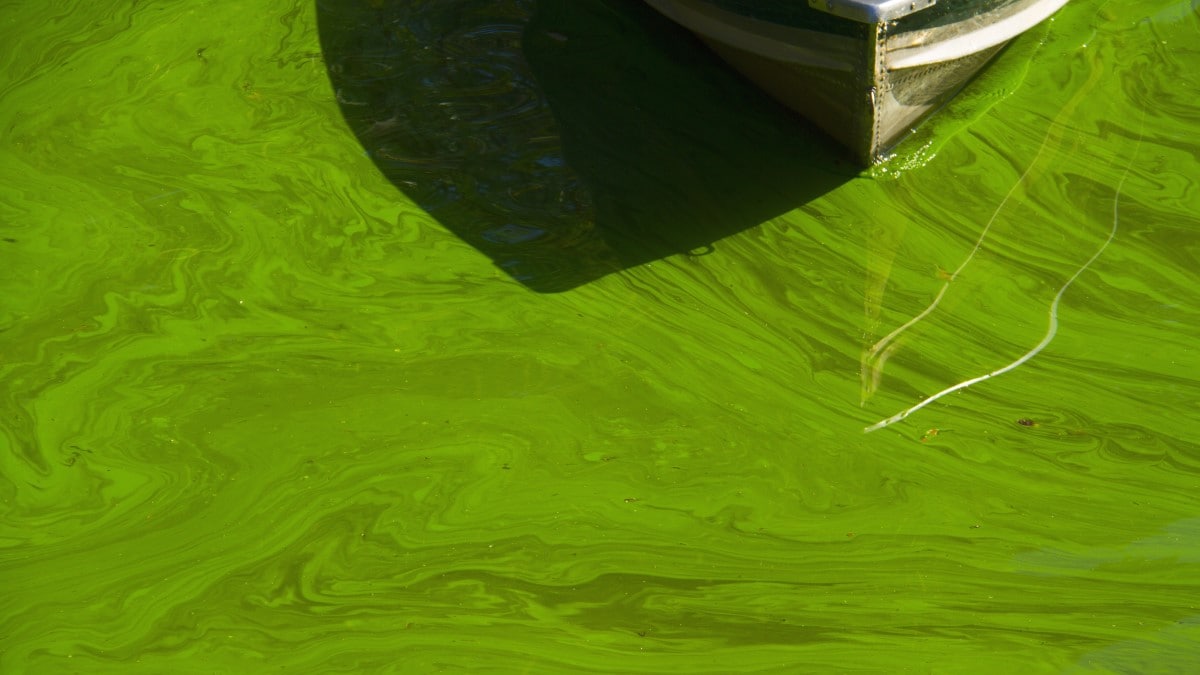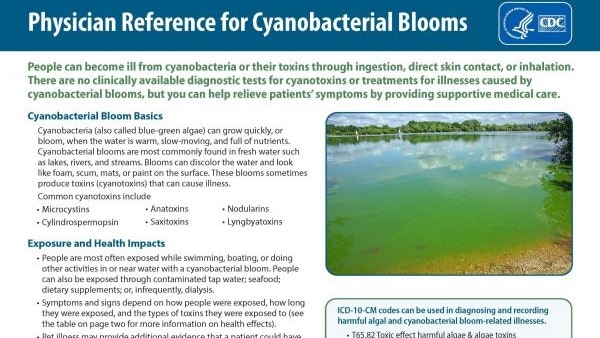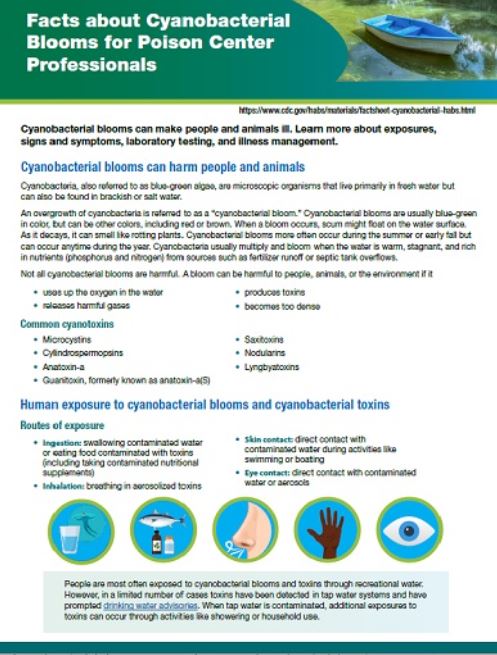Key points
- Harmful blooms of cyanobacteria are most commonly found in fresh water such as lakes, rivers, and streams.
- Signs and symptoms caused by these harmful algal blooms vary based on toxin and exposure.
- Illnesses can be mild to life-threatening.

Ingestion
People may ingest cyanobacteria or their toxins by:
- Swallowing water contaminated with cyanobacteria or their toxins
- Eating fish contaminated with toxins
- Swallowing blue-green algae supplements contaminated with toxins
Toxins and symptoms
Hepatotoxins and nephrotoxins
Microcystins and nodularins are hepatotoxins and nephrotoxins made by cyanobacteria. Ingesting these toxins can cause:
- Bad taste in mouth
- Loss of appetite
- Malaise or lethargy
- Headache or fever
- Nausea, vomiting, or diarrhea
- Blood in urine or dark urine
- Acute hepatitis or jaundice
Cylindrospermopsin is also a hepatotoxin and nephrotoxin made by cyanobacteria. Ingesting cylindrospermopsin can cause:
- Headache
- Fever
- Vomiting
- Bloody diarrhea
Neurotoxins
Anatoxins, guanitoxin (formerly known as anatoxin-a(S)), and saxitoxins are neurotoxins made by cyanobacteria. All three of these toxins can cause progression of muscle twitches when ingested. High doses of saxitoxin may cause progressive muscle paralysis.
Anatoxin-a can cause additional neurologic symptoms including:
- Tingling
- Numbness
- Burning sensation
- Drowsiness
- Salivation
- Speech disturbances
Skin or eye contact
People can have direct skin contact with water contaminated with cyanobacteria or their toxins during activities like swimming or boating. Their eyes may be exposed from contact with contaminated water or aerosols.
Contact with dermal toxins can cause:
- Allergic dermatitis, including rash, itching, or blisters
- Conjunctivitis
Inhalation
People may experience respiratory irritation as blooms of cyanobacteria die off and produce gases such as hydrogen sulfide and methane.
Dialysis
Rarely, dialysis patients have been exposed to the hepatotoxin microcystin through contaminated dialysis water.
Exposure to microcystin through dialysis water can cause:
- Liver damage
- Liver failure
- Death
Health effects research
Information about human health effects from exposure to cyanobacteria and their toxins is primarily derived from:
- A few epidemiology studies of recreational exposures
- Studies with laboratory animals
- Reports of extreme human exposure events, such as exposure to contaminated dialysis water
- Animal (cattle and dog) exposures
The long-term health effects of harmful algal blooms of cyanobacteria are being studied but remain unclear.
Resources
- Cyanobacterial Blooms and Associated Illnesses: A Clinician Training Module for Physicians and Healthcare Providers | ASTHO
- Health Effects from Cyanotoxins | U.S. EPA
- Blue-Green Algae Products and Microcystins | FDA
- Backer LB, McNeel SV, Barber T, Kirkpatrick B, Williams C, Irvin M, Zhou Y, Johnson TB, Nierenberg K, Aubel M, LePrell R, Chapman A, Foss A, Corum S, Hill VR, Kieszak SM, Cheng Y-S. Recreational exposure to microcystins during algal blooms in two California lakes. Toxicon. 2010;55(5):909-21.
- Backer LC, Carmichael W, Kirkpatrick B, Williams C, Irvin M, Zhou Y, Johnson TB, Nierenberg K, Hill VR, Kieszak SM, Cheng Y-S. Recreational exposure to microcystins during a Microcystis aeruginosa bloom in a small lake. In Mayer AMS (ed). Marine Drugs. 2008;6(2):389-406.
- Dietrich DR, Fischer A, Michel C, Höger SJ. Toxin mixture in cyanobacterial blooms–a critical comparison of reality with current procedures employed in human health risk assessment. Adv Exp Med Biol. 2008;619:885-912.
- Fosso-Kankeu E, Du Preez H, Jagals P. Health implications of lipopolysaccharide endotoxins in domestic container water used by rural households in South Africa. J Water Health. 2010;8(4):601-10.
- Gilroy DJ, Kauffman KW, Hall RA, Huang X, Chu FS. Assessing potential health risks from microcystin toxins in blue-green algae dietary supplements. Environ Health Perspect. 2000;108(5):435-39.
- Lavery, A., Backer, L., Daniel, J. Evaluation of Electronic Health Records to Monitor Illness From Harmful Algal Bloom Exposure in the United States. Journal of Environmental Health. 2021;83(9):8-14.
- Osborne NJ, Shaw GR, Webb PM. Health effects of recreational exposure to Moreton Bay, Australia waters during a Lyngbya majuscula bloom. Environ Int. 2007;33(3):309-14.
- Osborne NJ, Webb PM, Shaw GR. The toxins of Lyngbya majuscula and their human and ecological health effects. Environ Int. 2001;27(5):381-92.
- Stewart I, Schluter PJ, Shaw GR. Cyanobacterial lipopolysaccharides and human health – a review. Environ Health. 2006;5:7.
- Stewart I, Seawright AA, Schluter PJ, Shaw GR. Primary irritant and delayed-contact hypersensitivity reactions to the freshwater cyanobacterium Cylindrospermopsis raciborskii and its associated toxin cylindrospermopsin. BMC Dermatol. 2006;6:5.
- Stewart I, PM Webb, PJ Schluter, LE Fleming, JW Burns, Jr., M Gantar, LC Backer, GR Shaw. Acute effects of recreational exposure to freshwater cyanobacteria—a prospective epidemiology study. In: Harmful Algae 2002. Proceedings of the Xth International Conference on Harmful Algae. Steidinger, KA, JH Landsberg, CR Thomas, and GA Vargo (Eds). Florida Fish and Wildlife Conservation Commission and Intergovernmental Oceanographic Commission of UNESCO, 2003.


